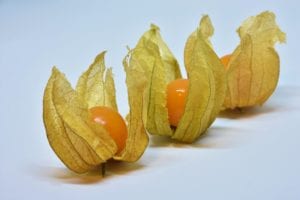Ithaca, New York, USA
December 9, 2019
Note: this article originally appeared in the Cornell Cooperative Extension Garden Post newsletter

Most gardeners love to try new things and many of you have already eaten, if not grown, groundcherries. But did you know there are two closely related species, Physalis pruinosa, and P. peruviana? One is the groundcherry and the other is often called goldenberry, but which is which? The confusion begins with the numerous common names for each and extends to seed catalogs which also mix them up! Let’s clarify: Goldenberry (P. peruviana) originated in South America and presently grows wild around the world and is considered a perennial in tropical regions. The large, upright plant (4-6 feet) has a woody stem and a long growing season, about 120 days to ripening. When the fruit is ripe, it is harvested directly from the plant. The fruit has a tartness to it and is about ¾ inch in diameter.
Groundcherry (P. pruinosa) is native to parts of Mexico and Central America. The species was widely grown by the Pennsylvania Dutch in the early 1800s. The stems are herbaceous, low and spreading, but the fruit begins to ripen in just 75 days and has a long ripening season. Groundcherries drop their fruit when ripe and are harvested from the ground (hence the name). The small fruits are sweet and are roughly ½ inch diameter.
The Physalis genus is part of the Solanaceae family (tomato, pepper, potato, eggplant, deadly nightshade) and also includes P. ixocarpa, the tomatillo. You may also know the ornamental plant P. alkekengi , the Chinese Lantern with the bright orange-red papery covering on the berries.
Physalis do well on well-drained, even sandy soils. The fruit is ripe when the papery husk turns light brown and translucent and the golden berries are visible through the husk. The fruit does not continue to ripen after harvest, so for groundcherries, any unripe fruit that fall on the ground can be discarded. Leave the fruit in the husk and it will keep at room temperature for abut 3 months. You can also leave it on the ground for days to weeks until you get around to harvesting. Assuming they are protected from critters.
The sprawling growth habit and dropping of ripe groundcherries makes harvest difficult. Some have tried to trellis them but the branches like to be horizontal. Here is where black plastic will make harvest much easier, rather than scooping up mulch or dirt along with your berries. Raised beds will also help you reach under the vines. The goldenberry, being woody and upright to begin with, does well with trellising and harvesting involves picking, like any other crop. Goldenberry plants do need to be started indoors in March, to ensure harvest beginning in July that will last through the season.
Physalis fruit are a good source of vitamins A and C, linoleic acid and antioxidants and the groundcherry flavor has been described as somewhat like a pineapple. They are fun to eat by themselves but you will have so many that you may want to investigate recipes for chutney, jelly, chili, salsa, and other dishes.
The Physalis Improvement Project, led by Dr. Joyce Van Eck of the Boyce Thompson Institute, explores the cultivation of peruviana and pruinosa in New York State and the potential for local food systems. Part of their research has been pest resistance. The three-lined potato beetle is a major pest, especially in the larval phase and in the first 2 weeks of June. They found it is best to remove the eggs, the frassy larvae and the adults in the early season through June. Just toss the pests in a pan of soapy water. The goldenberry has been shown to be much more attractive to the potato beetle than the groundcherry and one might try using the goldenberry as a trap crop to keep the pest off your groundcherry plants. However if your groundcherries are vigorous they can survive a little insect predation. Starting them indoors will give them a head start. So why not give them a try next season?